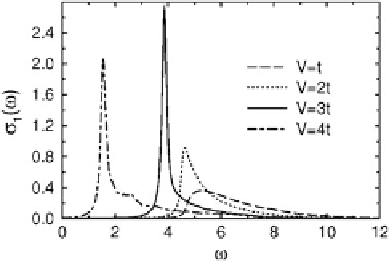Chemistry Reference
In-Depth Information
Fig. 8.18 Spectra calculated
by DDMRG for the extended
Hubbard model with
U ¼
8
t
.
t
is the same as
t
0
. Reprinted
figure with permission from
Jeckelmann [
30
]. Copyright
(2003) by the American
Physical Society
CDW-Mott-insulator boundary, which we will mention at the end of this chapter,
do not occur here.
Next, we proceed to the case in the presence of the nearest-neighbor repulsion,
which is indispensable for the consideration of the Ni compounds. Detailed
calculations over various combinations of
U
and
V
are performed for the extended
Hubbard model [
30
] and the
dp
model [
31
]. These calculations, which are also
based on the DDMRG method, reproduce the feature seen in the Ni compounds,
namely, the sharpness of the main peak and its long tail on the higher-energy side,
as shown in Fig.
8.18
(particularly the graph of
V ¼
3).
Here, we instead introduce a very simple model, i.e., a so-called doublon-holon
model [
32
,
33
], as
H
dh
¼t
0
X
l
:Þt
0
X
l
:ÞþV
X
l
ðd
lþ
1
d
l
þ
ðh
lþ
1
h
l
þ
n
ðd
l
n
ðhÞ
h.c
h.c
lþ
1
;
(8.23)
where
d
l
and
h
l
are the doublon and holon operators, respectively, and
n
ðd
l
and
n
ðhÞ
l
are their number operators. Note that
d
l
is not the operator of the d electron. This
model is regarded as an effective model of the extended Hubbard model with the
infinite
U
, in the following meaning.
First of all, the ground states are the states of single occupancy in this limit, as we
have already mentioned. Furthermore, the spin states heavily degenerate because of
the vanishing
J
value. In other words, any spin configuration satisfying an assigned
value of the total
S
z
can be a ground state. In Fig.
8.19a
, we assume one spin
configuration. Here, we no more assume the antiferromagnetic spin configuration.
The doublon and the holon are then the states with one electron added or removed,
as illustrated in Fig.
8.19b, c
, and their pair state is also shown in Fig.
8.19d
. Here, it
will be better to give the present definition of each state. The ground state is
expressed as
jgiC
1
"
C
5
"
C
6
"
C
7
"
C
2
#
C
3
#
C
4
#
C
8
#
j
, corresponding to Fig.
8.19a
,
in our “up-down” definition. Note that the spin-up operators come before the down
ones. Let us think about the movement of the holon first. To move it by one unit to
the right, we just transfer the up-spin electron at the right n. n. site to this site. Since
there is no need for the sign change, it gives a matrix element
0
i
t
0
as appearing in

Search WWH ::

Custom Search